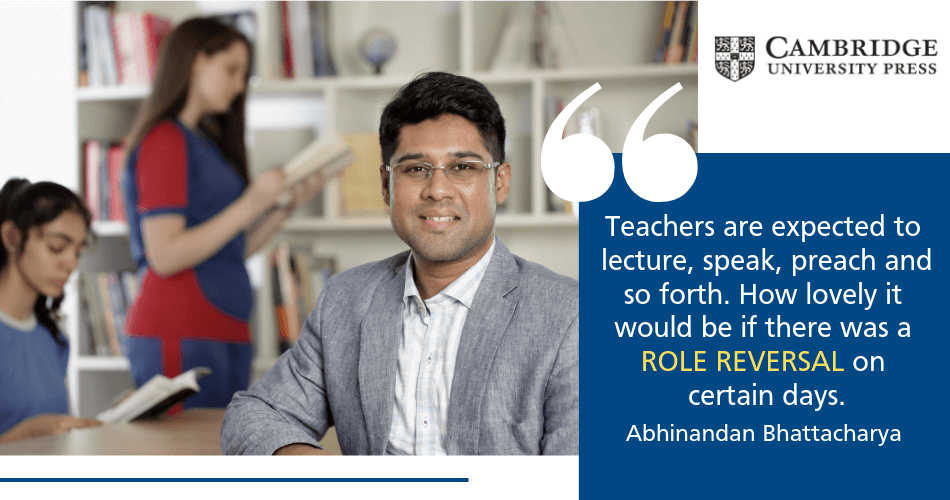Karl A. Menniger had so rightly put in, ‘Listening is a magnetic and strange thing, a creative force. The friends who listen to us are the ones we move toward. When we are listened to, it creates us, makes us unfold and expand.’ While imparting education in a classroom setting, a teacher should exercise the art of listening.
Learners today are born with an extra layer of inquisitive attitude owing to smart phones and access to internet.
They have myriad thoughts and questions storming their minds, waiting to be satiated by the most befitting response. Given this situation, the challenges that a teacher’s path is beset by are quite interesting. Gone are the days when the teachers should enter the classroom to simply speak, it’s very important to understand the importance of power of listening.
Imparting quality education should not be a one-way process
A teacher in the present-day classroom is an important facilitator. The actual resources necessary to plan a lesson are the audience right in front of us – the learners.
Let the learners speak their heart out as there are so many benefits of doing so-
- This enables and empowers the teacher to know how to custom- make and tailor the lesson to suit the needs of the present learners.
- It does away with any scope for monotony and repetition of the strategies or approaches that might have worked with a different set of learners in a different environment, because not all learners are the same.
Listen to what your students are NOT saying
With changing times, today it is common to have both parents that are working professionals. Parents want to provide the best for their children and the demands of their career may not allow them to spend as much time with the latter, as perhaps was the norm a few decades ago. Thus, the role of a teacher has gained significant prominence in a child’s life in terms of guidance, support and many a time just lending an ear, hence the importance of power of listening.
Listen to what your students are SAYING

Learners today are highly sensitive and crave every bit of your attention and they want a patient listener to anything that they have to say. It won’t be wrong to state that students today are more abreast of technology, development and innovative ideas than most of us are.
Many of the lessons in class can be shaped and designed taking a cue from discussion with your students.
Moreover, when learners are monitored and encouraged to share their ideas as a group or as individuals, a lot of peer learning, peer review and peer assessment takes place. This not only leads to effective classroom discipline and conduct, but also ensures holistic development of each learner.
Simultaneously, values like empathy, compassion, mindfulness, mutual understanding and respect and global mindedness are inculcated amongst the learners. Having said that, it should not be a mundane and routine affair either.
An efficient facilitator and teacher would know how to wield several activities that would involve equal participation from all learners where they get the opportunity to think, act, pair, share, analyze, review and evaluate their work and come up with strategies to better them too.
A teacher should simply initiate the topic of discussion and then take a backseat to let the learners start thinking for themselves.
Stretch and Challenge Activity
I had taken up an activity with my IGCSE FLE (0500) Grade 10 learners, a couple of months ago. I had shown my learners a video clip of an advertisement that advocated the idea of standing by tough moms.
After that, I simply instructed my learners to focus on the structure and style in Question 1 (Directed Writing in Paper 2). I also told them that each learner had to choose a text type in which they would want to transform their assignment. This was a case of ‘Stretch and Challenge’ where the learners had to frame the questions, rather than answering them first.
With a couple of more significant guidelines, I had before me about 15 different questions prepared as per the exam style chosen by the learners. The joy and happiness on their faces after they had finished this activity was unmatched.
Similarly, while teaching English Literature, I teach learners how to empathize by doing a role-play, hot seating, miming and so forth. This enables them to be independent outside the school premises.
After all, the sole objective of education is to raise a generation of life-long learners who will be capable to tread the path ahead without being dependent on the teacher.
_______________________________________
Abhinandan Bhattacharya was one of the 6 finalists of our Dedicated Teacher Awards. Out of 4,000 nominations from 140 countries, 50 entries were shortlisted and 6 finalists were chosen.
Read other informative articles on Teachers of Tomorrow to make your classroom more interesting.
What did you think about this article? Share it with us in the comments section.











